
Ming/Republican Shiwan Pottery
Guangdong Shiwan has a long history of ceramics production. The oldest known excavated kiln at Damao hill dated to the Tang/Song period. Some of the Shiwan ceramics wares were exported at least from the Northern Song period. Shiwan ceramics vessels of Tang to Yuan period are similar to those produced in other Guangdong kilns and not as prominent as those from Xicun or Chaozhou.
However, Shiwan emerged as the most important Guangdong ceramics production centre during the late Ming period. The thriving capitalism during the late Ming period stimulated the development of handicraft industries. Ceramics production benefited from the revival of commercialism and the lifting of ban on overseas trade. Foshan was one of the four famous town in China. It was an important commercial centre noted for coal production. Shiwan which is located 6 km southwest of Foshan benefited from its proximity to Foshan. Qu Wengshan (屈翁山) pointed out in his book "Guangdong Xin Yu" (广东新语) that pottery of Shiwan were sent to Guangdong, Guangxi and overseas.
The scale of the pottery production was huge. To ensure orderly development and prevent unhealthy competition in this industry, there was the need to set out the code of conducts. By Ming Jiajing, various pottery guilds were established. Till Ming Tianqi there were 8 guilds. However, by the Qing period, it evolved into more than 32 guilds. The guilds were based on vessel types produced by guild members and also some based on services required by the ceramics industry such as transportation of finished products, woods, clay and etc. Various pottery guilds based on vessel types include teapots, flowerpots, white glaze wares, black glaze wares and etc.
The Shiwan pottery industry mainly mass produced household vessels to meet the needs of the common folks, such as various sizes of jars and flower pots, bowls, plates, tea pot, pots for boiling herbs, vases and etc. Another important products are the various decorations for the ridge of the roof of temples. But Shiwan wares is particularly also noted for its production of figurines.

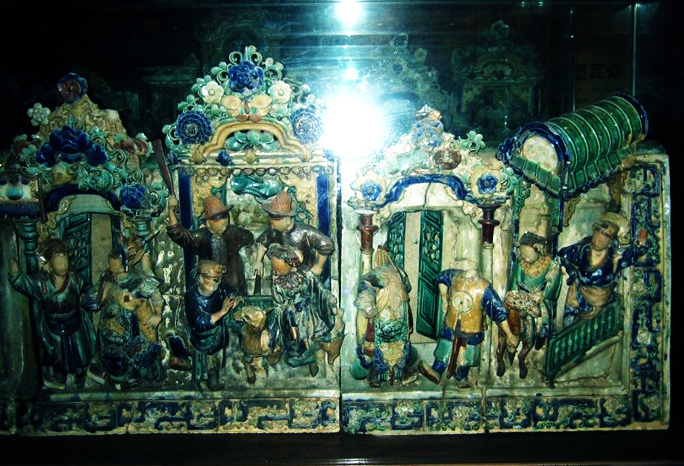
Interesting decorations on the roof ridge of temple
Generally, Shiwan pottery wares are heavy with a grayish body. The firing temperature for the biscuit is for pottery to stoneware range and hence not as high fired as porcelain. The glaze is thick and unctuous and fired at a low temperature with lead as the flux to lower the melting temperature.
Various Shiwan Glaze type
The biggest achievement of the Shiwan potters are in the area of creation of various glaze effects and making of figurines. The potters were skilled in imitating the various ancient monochrome glazes, sancai and also the more complex Jun glaze.
|
|
|
|
|
|
|
|
|
|
|
|
|
Some
examples of shiwan wares with the more common colour lead glaze
|
|
 |
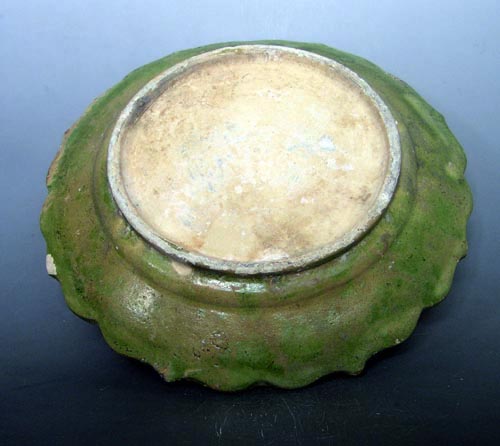 |
|
Qing Yongzheng Ca mau wreck Shiwan sancai plate |
|
Late Qing Ge Glaze Figurine
Qing Shiwan black glaze censer
In terms of glaze, it is particularly the Jun type glaze that Shiwan potters attained its highest achievement and honoured with the name Guang Jun. Jun glaze is a form of transmutation flambe glaze. For more on Song/Yuan Henan Jun wares, please read this. There is a distinctive difference between the Henan Jun and Guang Jun. The Henan Song/Yuan Jun flambe glaze consists of a single layer of glaze. On the other hand, Shiwan flambe glaze has a minimum of two layers. The bottom rust-colour layer served two purposes. It effectively fills up the small holes in the biscuit and also give a deeper, brighter and richer hue to the top layer glaze. However, it is interesting to note the visual similarity of Tang Jun and Guang Jun. Tang Jun have a base iron brown glaze and Jun type glaze splashes on some portions of the vessels.
|
|
|
| Note the visual similarity of the Tang Jun (the two shards example on the left of the left photo ) and the Qing Guang Jun on right photo | |
The Jun effect of Guang Jun are more varied, complex and interesting. Some fanciful names were given by the connoisseurs to describe the various the flambe effect, such as the famous "rain-sprinkled on wall" (雨淋墙)resembling the effect of sprinkles of rain hitting a wall or kingfisher's feather blue (翠毛蓝).
|
|
|
|
|
|
|
Qing 19th Century Guang Jun glaze plates |
|
Ming Guang Jun glaze in Guangdong Province Museum
Ming Shiwan kingfisher's feather blue (翠毛蓝) in Guangdong Province museum
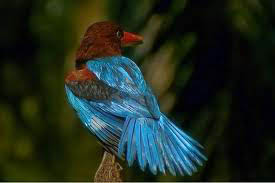
Kingfisher
Another rare type is the "carambola glaze" with its purplish-red mottled glaze effect. The more complex flambe effect may involve multiple applications of glaze.
|
|
|
|
| Qing Carambola glaze censer and below Carambola flower |
The Shiwan potters also came out with a distinctive form of monochrome red, which is termed pomegranate red. This type of glaze only appeared earliest only by Mid 19th century.
Republican pomegranate red glaze fish shape wall vases
Republican pomegranate red glaze figurine of Dong Fangsuo
Republican pomegranate red glaze figurine
Shiwan Figurines
Another most notable achievement of the
Shiwan potters is their sculpture. The figurines are more expressive,
lively and lifelike as compared to those from Jingdezhen. In the early
stage, mainly religious figurines such as Bodhidharma, laughing Buddha, Goddess
of Mercy, God of
Longevity, and etc were produced. Later on, more variety of figurines from historic, folklore
and popular literary works such as Romance of the 3 Kingdoms and Water
margin were introduced. As the Shiwan pottery also catered to a western
export market, figurines of foreign children, nudes and busts were also
produced. Shiwan potters paid particular attention to the facial
expression of the figurines. The expression may appear exaggerated but
aptly captured the unique character of the subject. To the potters, the spirit
is more important than the form. Cantonese opera strongly influenced the
potters. The similarity of the features of the subjects with those from
Cantonese opera is striking. But it is not just the form that
interest the potters. The opera performers were skilled in expressing the
unique character of the subject through their facial and body expression.
It is this ability of the potters to capture that spirit which breathed life to their
works. The rough quality of the Shiwan clay is especially suitable for
modeling of figurines with masculine quality . Hence, usually the face, the
hand and feet are left unglaze to fully project the masculine effect. If a
finer paste is required, the Shiwan clay is mixed with those imported from
Guangdong Dongguan which is fine and whiter. The Dongguang (东莞)
white clay
is used if a more feminine quality for the subject is required. From the
extant works, we can see that the best pieces only started to emerge from the
Mid 19th century onward. Representative master potters famed for the
modeling of figurines include Huang Bing(黄炳),
Huang Guzhen (黄古珍)from
Daoguang/Guangxu period, Chen Weiyan (陈谓岩),Chen
Chi (陈赤),Pan Yushu
(潘玉书)
from Guangxu/Republican
period, Huo Jin (霍津),
Wen Songling (温松龄),Liu
Zuochao (刘佐潮) from
the Republican period, and Ou Qian (
Late Qing/Republican Jun glaze figurine of Bodhidharma
Late Qing/Republican Jun glaze figurine of a scholar
Early Qing Celadon glaze Buddha Figurine


Late Qing Figurine of a boy by Chen Wei Yan

Republican Figurine of a buffalo by Huo Jin
19th Qing Figurine of a cat by Huang Bing
Many mass produced figurines were exported to Europe and American during the late Qing/Republican period. They were commonly termed mudman by the westerners. Majority are of mediocre quality and not reflective of the high artistic quality of the accomplished Shiwan potters.
|
|
| Some examples of the "mudman" produced for the export market during the late Qing /Republican period |
Marks on Shiwan Pottery
Some of the the Shiwan wares also carried seals marks of the potters, workshops or factories. The marks were intended as identification of the producer and also served to advertise the products. However, in view of the excellent reputation of some late Ming/Early Qing producers, their marks were copied even till the Republican period. Hence, it poses another aspect which complicate the authentication of the wares. For the late Qing/Republican pieces, the "made in China" mark is commonly found on export pieces.
Famous factory marks include:
Zu Tang Ju (祖唐居)- The factory dated from the late Ming period famous for the quality of its products. The monochrome and sancai wares, produced are mainly for daily use. There are many imitation of Zu Tang Ju during the late Qing/Republican period which consisted of figurines of Buddha and Luohan. In the Yongzheng period Vietnam Ca mau shipwreck, there were some sancai plates impressed with the Zu Tang Ju mark. The biscuit is of a light buff colour tone, fine grained and light.
Ming Shiwan yellow glaze censer with Zu Tang Ju mark
Qing Yongzheng Ca mau wreck sancai plate with Zu Tang Ju mark
Nan shi (南石)/ Nan Shi Tang(南石堂)/Wu Nanshi (吴南石) - Generally the wares in this category are noted for their quality. Some of the finest are in the form of vases and incense burners imitating bronze shapes. The biscuit is usually light buff, smooth and does not contain the coarse sand granules found on the most Shiwan wares.
Chen Yue Cai (陈月彩)- It is named after a supposedly famous late Ming potters. The wares produced are glazed in yellowish brown or green.
Wen Ru Bi (文如壁)- The shop is named after its owner who is a skilled potter. It operated from Qing Kangxi to early 20th century. Initially the shop was noted for its fine daily household items. However, later it became one of the main producer of roof ridge decoration. The shop was in operation over the Qing and Republican period. During the Republican period, it separated into two shops, one named Ru Bi Shang Ji (如壁生记。) and the other Ru Bi (如壁).
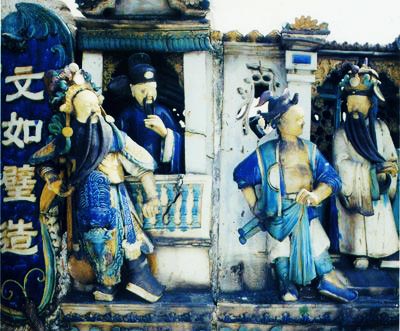
Bao Yu (宝玉)- It operated from Mid to late Qing period. It was famous for making flower pots, teapots and daily household items.
Liu Sheng Ji (刘胜记)- Liu Sheng Ji was a famous potter of Tongzhi/Guangxu period. His shop was set up during the Guangxu period and famous for making miniatures. One of his sons, Liu Zuo Chao (刘佐潮) who is an accomplished potter skilled in figurines, took over the business and continued to use the Liu Sheng Ji mark. Some of his works carried both the shop and potter mark.

Some famous marks of potters include:
Yang Ming (杨明)/Yang Sheng (杨昇) - Both are generally believed to be brothers active during the late Ming period. Yang Ming was famous for its powder blue glaze products. Many of his extant works were objects imitating form of archaic bronzes.
Ke Song (可松)- Late Ming potter famous for his imitation of Jun glazes. His extant works consisted of vessels in the form of archaic bronzes.
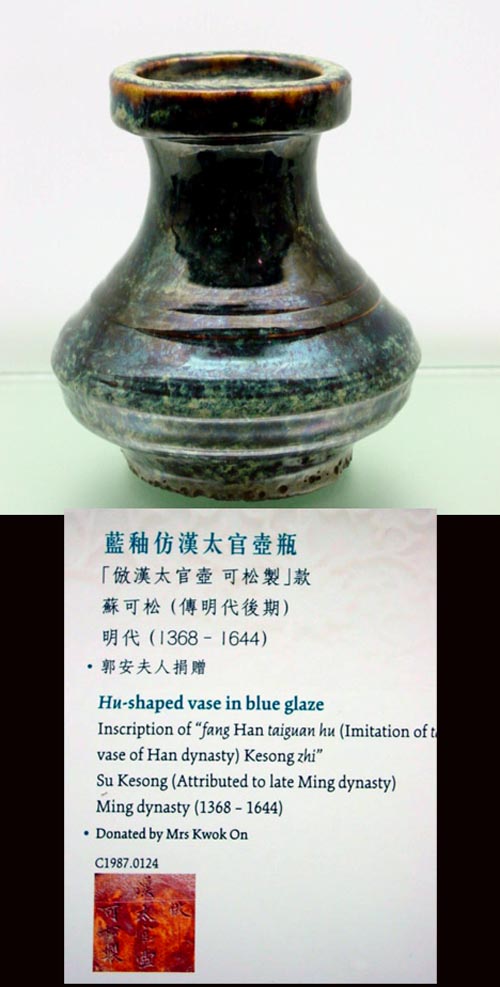
Huang Bing(黄炳) (also known as Yun Qu (云渠), Yun Yu (云屿) or Wanhai Jushi (湾海居士)) - He was active during the Daoguang/Guangxu period. He was famous for moulding birds, animals and human figurines. He is particularly famous for his duck and cat figurine. There existed many imitation of his works.
Ducks in biscuit by Huang Bing
Huang Guzhen (黄古珍)(Qiao Gu Shan Ren (樵谷山人)) - He was Huang bing's uncle but was 20 years younger. He made wares for daily use and figurines of bird, animal and human. He was also a skilled painter and many of his extant works were decorated with glazed colour landscape and calligraphy.
Chen Weiyan (陈谓岩)(also known as Yang Yun Jushi (养云居士)) - A famous potter of Qing Guangxu/Republican period. He was famed for his figurines. At one point of his life, he brought his disciple, Pan Yushu to Jingdezhen to share and learn the techniques of the Jingdezhen potters. Some of his extant Jingdezhen porcelain works such as Jia Baoyu (a character from the Romance of Red Chamber), was decorated using overglaze fencai, a decorative technique he learnt from the Jingdezhen potters.
Late Qing Figurine of Song poet Su Dongpo by Chen Weiyan
He was also famous for designing the Night pot of Ba Xiali (巴夏礼夜壶). Ba Xiali is the Chinese name for Parkes. Harry Smith Parkes was acting Consul at Guangdong and was believed by the Chinese to be the instigator of the Second Opium war. It resulted in the invasion of Guangdong. To the people of Guangdong, he was a much hated figure. To the common folks, urinating into the Night pot of Ba Xiali , became an avenue for venting anger and an expression of their anti-western imperialism sentiment.
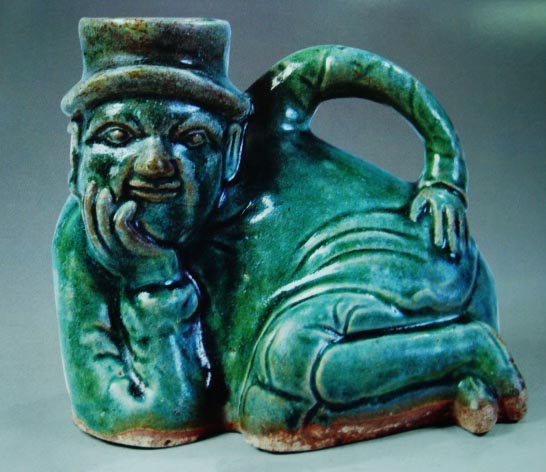
Night pot of Ba Xiali

Pan Yushu (潘玉书) - Disciple of Chen Wei Yan. He was active during the Guangxu/Republican period. He was famous for his figurines. He was not very skillful in preparation of the clay and as such many have manufacturing cracks after firing.

Huo Jin (霍津) - Active during the Republican period. Skilled in modelling of human and animal figurines. His work on buffalo is especially famous and its artistic excellence on par and usually mentioned together with Huang Bing's duck.
Ou Qian (
Liu Chuan (刘传) - Active during the late Republican period onward. He was famed for his human figurines. He was an all-rounder and good in building of kiln, selection of clay, glaze preparation and modeling.
19th/20th Vietnamese Shiwan-type Vessels
Many Chinese from Fujian and Guangdong settled down in Vietnam during the Ming/Qing period. One distinct physical evidence of their presence are the Chinese style temples. The roof of the temples are decorated with colour glazed ceramics depicting human subjects, animals, birds, flowers and etc. They are similar to those that were produced by the Guangdong Shiwan potters. In fact, those dated to the 18th/19th Century were indeed produced by Shiwan potters shipped to Vietnam. Some of the potters settled down in Vietnam and continued to produce the Shiwan type wares. Their descendents inherited the technology and ensured the continuity of this art form. Song Be about 100 km from Ho Chiminh was an important centre where such ceramics were produced. These Shiwan type wares are actually a continuity of the Tang 3 colour lead glaze wares. The Vietnamese version could be distinguished by the more porous paste. Stylistically the decorations also show some differences.
|
|
|
|
|
|
|
|
|
|
|
|
| Examples of Siwan type coloured glaze vessels dated to late 19th/early 20th century | |
Comparison of the Vietnamese (upper photo) and Shiwan Sun God and Moon Goddess
Cultural Revolution Shiwan Figurines
During the cultural revolution period of the 60/70s, many interesting
works of a propaganda nature were produced. Distinctive figurines depicted role models
to propagate the selfless quality to be emulated by the
common folks. Many figurines of the minority races were also produced as a
tool to spread the message of multi-racial unity. Many
of the works were designed by highly skilled potters, with quite a few now recognised as master artists such as Liu Ze Mian (刘泽棉),
Zhuang Jia (庄稼), Mei Wen
Ding (梅文鼎), Huang
Song Jian (黄松坚)and
Liao Hong Biao (
|
|
|
|
|
|
| Shiwan figurines from the Cultural Revolution Period |
For more on Shiwan ceramics of this period, please read below:
http://koh-antique.com/client/shiwanculturalrevolution.html
Concluding Remarks
After the cultural revolution, Shiwan potters have reverted to producing art works inspired by the ancient traditional culture. However due to the high demand of cultural revolution figurines, many imitations of that period are still being reproduced. Generally the quality, especially the facial expression, pales in comparison to work of the past. There are also some discernible differences in term of the paste and glaze which can be distinguished by experienced collectors.
Written by: NK Koh (22 Sep 2013), updated: 20 Dec 2018